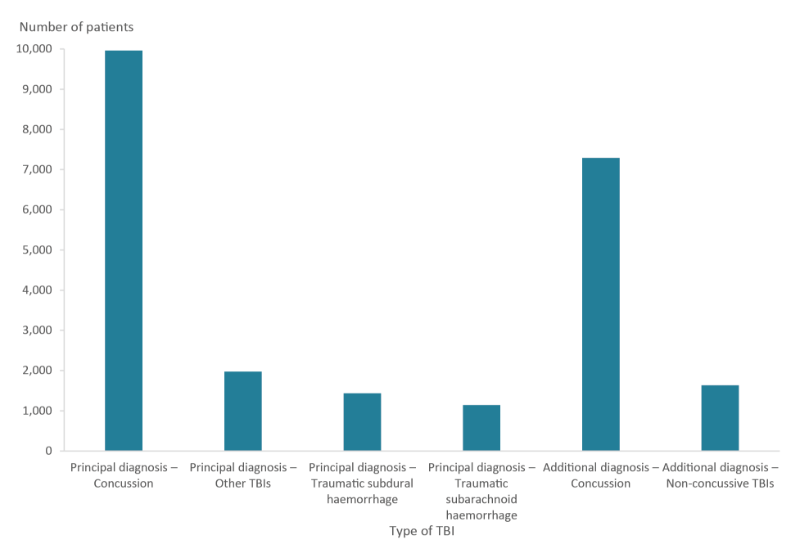Clinical characteristics
TBI diagnosis
Table 2 describes the main types of TBI identifiable in the NIHSI AA dataset.
| ICD-10-AM diagnosis | ICD-10-AM code | Condition description | Primary diagnosis – Concussion | Primary diagnosis – Traumatic subarachnoid haemorrhage | Primary diagnosis – Traumatic subdural haemorrhage | Primary diagnosis – Other TBI | Additional diagnosis – Concussion | Additional diagnosis – Non-concussive TBI |
|---|---|---|---|---|---|---|---|---|
| Concussive injury | S06.0 | Brain injury caused by a blow to the head or violent shaking of the head. May be with or without loss of consciousness |  |
 |
||||
| Traumatic subdural haemorrhage | S06.5 | Blood collects between the covering of the brain and the surface of the brain |  |
 |
||||
| Traumatic subarachnoid haemorrhage | S06.6 | Bleeding between the arachnoid (the middle membrane surrounding the brain) and pia mater (the inner membrane surrounding the brain) |  |
 |
||||
| Traumatic cerebral oedema | S06.1 |
Swelling of the brain |  |
 |
||||
| Diffuse brain injury | S06.02 | Wide area of brain tissue is affected |  |
 |
||||
| Focal brain injury | S06.03 | Localised or limited brain tissue affected |  |
 |
||||
| Epidural haemorrhage | S06.04 | Bleeding between the inside of the skull and the dura mater (the outer membrane surrounding the brain) |  |
 |
||||
| Other intracranial injuries | S06.08 | Other intracranial injuries such as traumatic haemorrhage, haematoma or contusion |  |
 |
Note that the ‘Principal diagnosis – Other TBIs’ and ‘Additional diagnosis – Non-concussive TBIs’ categories comprise different sets of conditions. This is because within the TBI as a principal diagnosis set, traumatic subarachnoid haemorrhage and traumatic subdural haemorrhage are reported separately, while within the TBI as additional diagnosis data, they are included in the ‘Additional diagnosis – Non-concussive TBI’ category, because the number of cases was very low.
For over 14,500 people (62%) in the cohort, the TBI was the principal diagnosis, meaning TBI was the main reason they were admitted to hospital (Figure 3; Table S1). The remainder of the cohort (38%) had TBI recorded as an additional diagnosis, alongside a different principal diagnosis that was the chief reason for hospital admission.
Concussion, with or without loss of consciousness, was the most common type of TBI diagnosis, representing 74% (17,250 cases) of initial TBI admissions.
Figure 3: Number of cohort patients by TBI diagnosis

Source: AIHW NIHSI AA v0.5.


